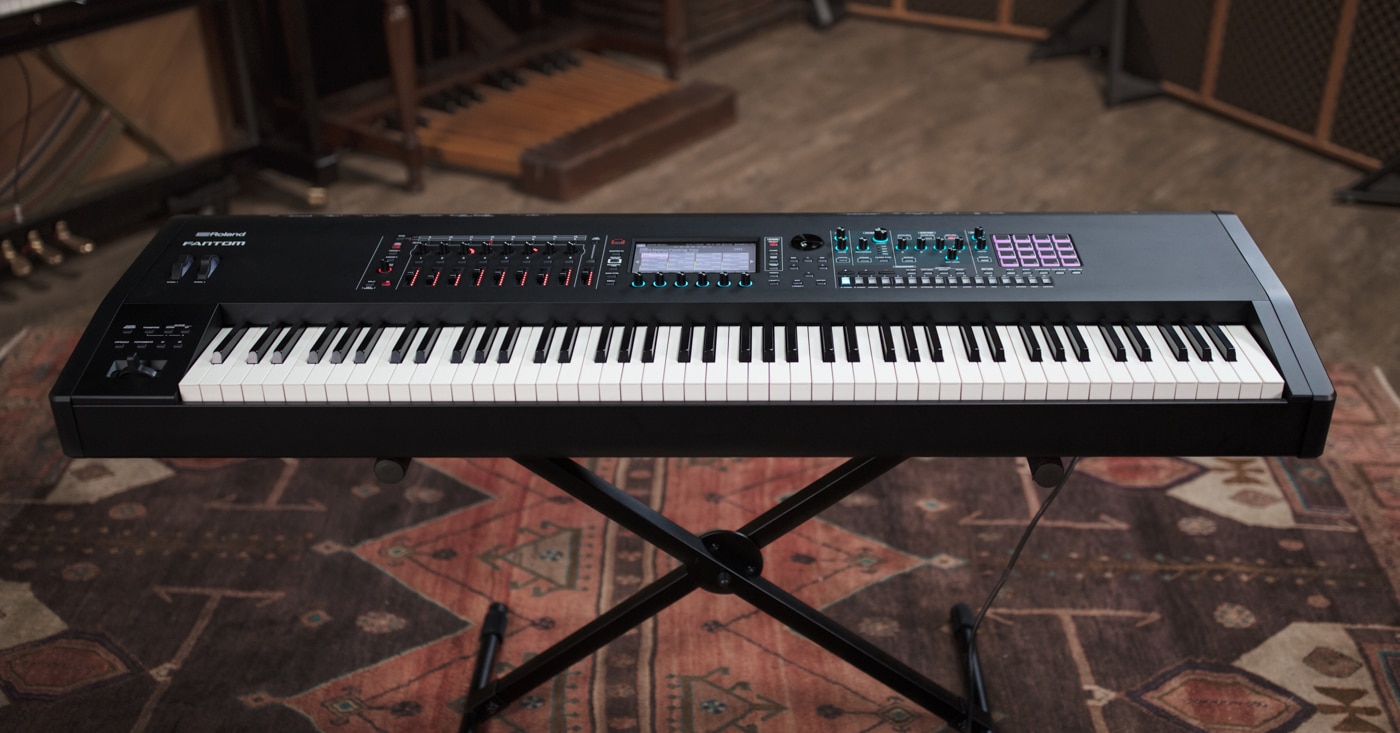Roland has introduced FANTOM, the latest generation of their feature-packed flagship workstation/synthesizer, available in 61-key, 76-key and 88-key models. To learn more about FANTOM and what differentiates this from previous models, we reached out to Brandon Ryan, Global Strategic Product Marketing Manager.
The HUB: Looking at the previous generations of FANTOM, what would you consider to be the biggest changes to workflow in the new model?
Brandon Ryan: This new FANTOM was designed with modern workflow and production techniques in mind. A lot was considered about how people create and perform music these days, and what their expectations would be for an instrument of this kind in 2019. For instance, the new FANTOM doesn't really have "modes". Historically, each “mode” would have its own set of capabilities and limitations. Instead, you have "Scenes" where you can save and recall an entire setup with layers of sounds, effects, and other settings. It's just one mode, with 16 layers that you can do with what you wish. You can even make a layer using a soft synth from your computer, and work with it right on the touchscreen.
When you're ready to create something, you record into a matrix of patterns or "clips". You can record variations, and trigger rows of these clips in any combination, much like in some modern DAWs. And then there's multichannel audio transfer between FANTOM and your computer over USB, with intuitive DAW integration so you can finish songs there. I could go on and on. Essentially, the new model is a "turn it on and go" kind of instrument, with a more seamless creative experience.
Dig deeper into Roland's FANTOM with our demo video.
The HUB: How do you create a new FANTOM that lives up to the legacy of the name?
BR: Well, it has to pretty much do it all, including looking and playing great, and withstanding the rigors of the road. It's a pro instrument and we designed it as such. This new FANTOM line has the best keybeds we've ever made...and they’re pretty amazing if you ask me. It's made of metal, has great feeling controls, a responsive touch screen, balanced XLR outs, routable sub outputs, multiple pedal inputs, the Roland pitch/mod lever, plus pitch and mod wheels. We worked very hard to put in just about anything today's serious keyboardist might need.
The HUB: What’s the most performance-friendly feature of FANTOM?
BR: Hmmmm...I'm torn. I can't discount the keyboard feel, which for me personally is probably my all-time favorite. But outside of that, it's probably the dedicated synth control section. Endless encoder knobs are great, and FANTOM has them, but it's hard to beat the feel of a nice large filter cutoff knob or dedicated envelope controls, in addition to the usual all-purpose knobs and sliders.
The HUB: CV I/O and analog filters are not the types of things typically put on a “workstation”, a term associated with previous generation FANTOMs. What lead to this decision?
BR: Well, we made FANTOM to be a kind of "creative hub" where you can pull in everything from soft synths to analog modular and make it all work together—to create a big, diverse sonic palette in a single creative workspace. Again, it's about the modern workflow, especially with the ongoing trend of popular music incorporating more and more sounds and production techniques from electronic genres. We felt this new instrument needed to let you seamlessly work with plugin synths or modular hardware—or both. And who doesn't love an analog filter?
The HUB: Do you have a favorite sound?
BR: That’s a tough one! For pure majestic synth goodness, I'd call out "Fanfare". It's a huge stack with zones that uses everything from PCM trumpets to various legendary filters and analog modeled oscillators. And there's some nice, subtle LFO generated movement going on that evolves over time. It can get calm and quiet or big and brash, responding to velocity, aftertouch, and the dedicated synth controls, of course.
The HUB: As a sound designer, what excites you most about the on-board engine?
BR: I think it's the ability to mix and match different kinds of synthesis. The new FANTOM has an oscillator sync function that works with PCM waves and it has a very cool, distinctive sound. Combine this with models of classic oscillators and filters and you can get some very fresh new sounds. And then you have V-Piano onboard as well as other acoustic waveforms that you can mix in resulting in some very interesting and unusual "hybrid" type sounds.
The HUB: What makes this FANTOM uniquely Roland?
BR: The 16-step TR-style sequencer is intrinsically Roland and a natural for making drum tracks. It's the kind found on our classic drum machines like the TR-808 and 909. There are also a number of oscillator and filter models of vintage Roland synths like the JUNO-106 and JUPITER-8, not to mention the well- known choruses and delays. All these kinds of things add up to give it that Roland feel and a distinctly Roland sound.
The HUB: Brandon, thanks so much for your time!
Roland’s FANTOM is available in three formats: FANTOM-6, FANTOM-7 and FANTOM-8. Order yours today!







































































































































